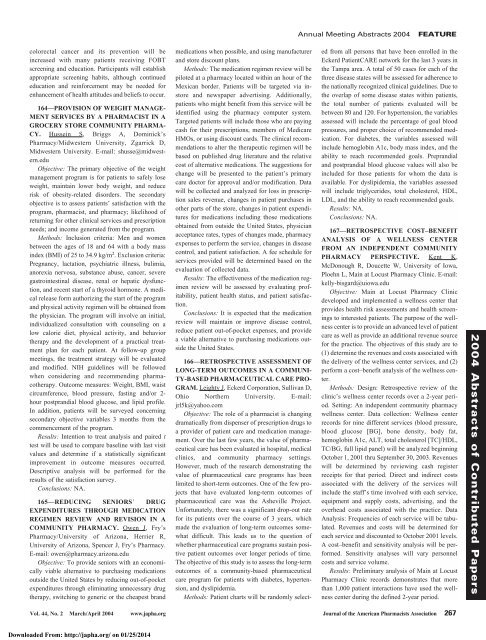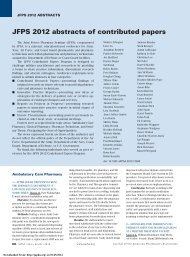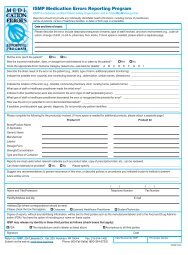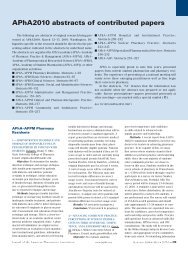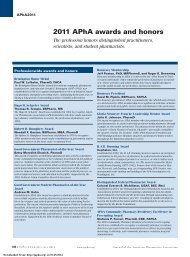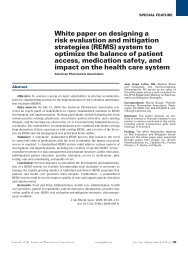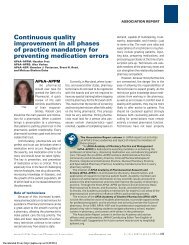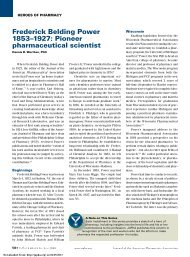Downloaded - Journal of American Pharmacists Association
Downloaded - Journal of American Pharmacists Association
Downloaded - Journal of American Pharmacists Association
Create successful ePaper yourself
Turn your PDF publications into a flip-book with our unique Google optimized e-Paper software.
Annual Meeting Abstracts 2004<br />
FEATURE<br />
colorectal cancer and its prevention will be<br />
increased with many patients receiving FOBT<br />
screening and education. Participants will establish<br />
appropriate screening habits, although continued<br />
education and reinforcement may be needed for<br />
enhancement <strong>of</strong> health attitudes and beliefs to occur.<br />
164—PROVISION OF WEIGHT MANAGE-<br />
MENT SERVICES BY A PHARMACIST IN A<br />
GROCERY STORE COMMUNITY PHARMA-<br />
CY. Hussein S, Briggs A, Dominick’s<br />
Pharmacy/Midwestern University, Zgarrick D,<br />
Midwestern University. E-mail: shusse@midwestern.edu<br />
Objective: The primary objective <strong>of</strong> the weight<br />
management program is for patients to safely lose<br />
weight, maintain lower body weight, and reduce<br />
risk <strong>of</strong> obesity-related disorders. The secondary<br />
objective is to assess patients’ satisfaction with the<br />
program, pharmacist, and pharmacy; likelihood <strong>of</strong><br />
returning for other clinical services and prescription<br />
needs; and income generated from the program.<br />
Methods: Inclusion criteria: Men and women<br />
between the ages <strong>of</strong> 18 and 64 with a body mass<br />
index (BMI) <strong>of</strong> 25 to 34.9 kg/m 2 . Exclusion criteria:<br />
Pregnancy, lactation, psychiatric illness, bulimia,<br />
anorexia nervosa, substance abuse, cancer, severe<br />
gastrointestinal disease, renal or hepatic dysfunction,<br />
and recent start <strong>of</strong> a thyroid hormone. A medical<br />
release form authorizing the start <strong>of</strong> the program<br />
and physical activity regimen will be obtained from<br />
the physician. The program will involve an initial,<br />
individualized consultation with counseling on a<br />
low calorie diet, physical activity, and behavior<br />
therapy and the development <strong>of</strong> a practical treatment<br />
plan for each patient. At follow-up group<br />
meetings, the treatment strategy will be evaluated<br />
and modified. NIH guidelines will be followed<br />
when considering and recommending pharmacotherapy.<br />
Outcome measures: Weight, BMI, waist<br />
circumference, blood pressure, fasting and/or 2-<br />
hour postprandial blood glucose, and lipid pr<strong>of</strong>ile.<br />
In addition, patients will be surveyed concerning<br />
secondary objective variables 3 months from the<br />
commencement <strong>of</strong> the program.<br />
Results: Intention to treat analysis and paired t<br />
test will be used to compare baseline with last visit<br />
values and determine if a statistically significant<br />
improvement in outcome measures occurred.<br />
Descriptive analysis will be performed for the<br />
results <strong>of</strong> the satisfaction survey.<br />
Conclusions: NA.<br />
165—REDUCING SENIORS’ DRUG<br />
EXPENDITURES THROUGH MEDICATION<br />
REGIMEN REVIEW AND REVISION IN A<br />
COMMUNITY PHARMACY. Owen J, Fry’s<br />
Pharmacy/University <strong>of</strong> Arizona, Herrier R,<br />
University <strong>of</strong> Arizona, Spencer J, Fry’s Pharmacy.<br />
E-mail: owen@pharmacy.arizona.edu<br />
Objective: To provide seniors with an economically<br />
viable alternative to purchasing medications<br />
outside the United States by reducing out-<strong>of</strong>-pocket<br />
expenditures through eliminating unnecessary drug<br />
therapy, switching to generic or the cheapest brand<br />
medications when possible, and using manufacturer<br />
and store discount plans.<br />
Methods: The medication regimen review will be<br />
piloted at a pharmacy located within an hour <strong>of</strong> the<br />
Mexican border. Patients will be targeted via instore<br />
and newspaper advertising. Additionally,<br />
patients who might benefit from this service will be<br />
identified using the pharmacy computer system.<br />
Targeted patients will include those who are paying<br />
cash for their prescriptions, members <strong>of</strong> Medicare<br />
HMOs, or using discount cards. The clinical recommendations<br />
to alter the therapeutic regimen will be<br />
based on published drug literature and the relative<br />
cost <strong>of</strong> alternative medications. The suggestions for<br />
change will be presented to the patient’s primary<br />
care doctor for approval and/or modification. Data<br />
will be collected and analyzed for loss in prescription<br />
sales revenue, changes in patient purchases in<br />
other parts <strong>of</strong> the store, changes in patient expenditures<br />
for medications including those medications<br />
obtained from outside the United States, physician<br />
acceptance rates, types <strong>of</strong> changes made, pharmacy<br />
expenses to perform the service, changes in disease<br />
control, and patient satisfaction. A fee schedule for<br />
services provided will be determined based on the<br />
evaluation <strong>of</strong> collected data.<br />
Results: The effectiveness <strong>of</strong> the medication regimen<br />
review will be assessed by evaluating pr<strong>of</strong>itability,<br />
patient health status, and patient satisfaction.<br />
Conclusions: It is expected that the medication<br />
review will maintain or improve disease control,<br />
reduce patient out-<strong>of</strong>-pocket expenses, and provide<br />
a viable alternative to purchasing medications outside<br />
the United States.<br />
166—RETROSPECTIVE ASSESSMENT OF<br />
LONG-TERM OUTCOMES IN A COMMUNI-<br />
TY-BASED PHARMACEUTICAL CARE PRO-<br />
GRAM. Leighty J, Eckerd Corporation, Sullivan D,<br />
Ohio Northern University. E-mail:<br />
jrl5k@yahoo.com<br />
Objective: The role <strong>of</strong> a pharmacist is changing<br />
dramatically from dispenser <strong>of</strong> prescription drugs to<br />
a provider <strong>of</strong> patient care and medication management.<br />
Over the last few years, the value <strong>of</strong> pharmaceutical<br />
care has been evaluated in hospital, medical<br />
clinics, and community pharmacy settings.<br />
However, much <strong>of</strong> the research demonstrating the<br />
value <strong>of</strong> pharmaceutical care programs has been<br />
limited to short-term outcomes. One <strong>of</strong> the few projects<br />
that have evaluated long-term outcomes <strong>of</strong><br />
pharmaceutical care was the Asheville Project.<br />
Unfortunately, there was a significant drop-out rate<br />
for its patients over the course <strong>of</strong> 3 years, which<br />
made the evaluation <strong>of</strong> long-term outcomes somewhat<br />
difficult. This leads us to the question <strong>of</strong><br />
whether pharmaceutical care programs sustain positive<br />
patient outcomes over longer periods <strong>of</strong> time.<br />
The objective <strong>of</strong> this study is to assess the long-term<br />
outcomes <strong>of</strong> a community-based pharmaceutical<br />
care program for patients with diabetes, hypertension,<br />
and dyslipidemia.<br />
Methods: Patient charts will be randomly selected<br />
from all persons that have been enrolled in the<br />
Eckerd PatientCARE network for the last 3 years in<br />
the Tampa area. A total <strong>of</strong> 50 cases for each <strong>of</strong> the<br />
three disease states will be assessed for adherence to<br />
the nationally recognized clinical guidelines. Due to<br />
the overlap <strong>of</strong> some disease states within patients,<br />
the total number <strong>of</strong> patients evaluated will be<br />
between 80 and 120. For hypertension, the variables<br />
assessed will include the percentage <strong>of</strong> goal blood<br />
pressures, and proper choice <strong>of</strong> recommended medication.<br />
For diabetes, the variables assessed will<br />
include hemoglobin A1c, body mass index, and the<br />
ability to reach recommended goals. Preprandial<br />
and postprandial blood glucose values will also be<br />
included for those patients for whom the data is<br />
available. For dyslipidemia, the variables assessed<br />
will include triglycerides, total cholesterol, HDL,<br />
LDL, and the ability to reach recommended goals.<br />
Results: NA.<br />
Conclusions: NA.<br />
167—RETROSPECTIVE COST–BENEFIT<br />
ANALYSIS OF A WELLNESS CENTER<br />
FROM AN INDEPENDENT COMMUNITY<br />
PHARMACY PERSPECTIVE. Kent K,<br />
McDonough R, Doucette W, University <strong>of</strong> Iowa,<br />
Ploehn L, Main at Locust Pharmacy Clinic. E-mail:<br />
kelly-bisgard@uiowa.edu<br />
Objective: Main at Locust Pharmacy Clinic<br />
developed and implemented a wellness center that<br />
provides health risk assessments and health screenings<br />
to interested patients. The purpose <strong>of</strong> the wellness<br />
center is to provide an advanced level <strong>of</strong> patient<br />
care as well as provide an additional revenue source<br />
for the practice. The objectives <strong>of</strong> this study are to<br />
(1) determine the revenues and costs associated with<br />
the delivery <strong>of</strong> the wellness center services, and (2)<br />
perform a cost–benefit analysis <strong>of</strong> the wellness center.<br />
Methods: Design: Retrospective review <strong>of</strong> the<br />
clinic’s wellness center records over a 2-year period.<br />
Setting: An independent community pharmacy<br />
wellness center. Data collection: Wellness center<br />
records for nine different services (blood pressure,<br />
blood glucose [BG], bone density, body fat,<br />
hemoglobin A1c, ALT, total cholesterol [TC]/HDL,<br />
TC/BG, full lipid panel) will be analyzed beginning<br />
October 1, 2001 thru September 30, 2003. Revenues<br />
will be determined by reviewing cash register<br />
receipts for that period. Direct and indirect costs<br />
associated with the delivery <strong>of</strong> the services will<br />
include the staff’s time involved with each service,<br />
equipment and supply costs, advertising, and the<br />
overhead costs associated with the practice. Data<br />
Analysis: Frequencies <strong>of</strong> each service will be tabulated.<br />
Revenues and costs will be determined for<br />
each service and discounted to October 2001 levels.<br />
A cost–benefit and sensitivity analysis will be performed.<br />
Sensitivity analyses will vary personnel<br />
costs and service volume.<br />
Results: Preliminary analysis <strong>of</strong> Main at Locust<br />
Pharmacy Clinic records demonstrates that more<br />
than 1,000 patient interactions have used the wellness<br />
center during the defined 2-year period.<br />
2004 Abstracts <strong>of</strong> Contributed Papers<br />
Vol. 44, No. 2 March/April 2004 www.japha.org <strong>Journal</strong> <strong>of</strong> the <strong>American</strong> <strong>Pharmacists</strong> <strong>Association</strong> 267<br />
<strong>Downloaded</strong> From: http://japha.org/ on 01/25/2014


